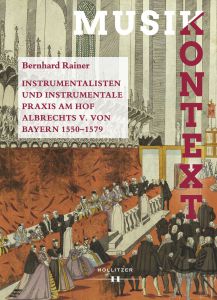Bernhard Rainer: Instrumentalisten und instrumentale Praxis am Hof Albrechts V. von Bayern 1550–1579 [Instrumentalists and Instrumental Practice at the Court of Albrecht V of Bavaria, 1550–1579] 2021, Vienna: Hollitzer Verlag, (Musikkontext 16), 304 pp., with illustrations.
For those who’ve thus far heard music by Orlando di Lasso performed mainly as a cappella “vocal music”, Bernhard Rainer’s book presents an opportunity to discover some new aspects—such as how Lasso effectively staged music via its arrangement, instrumentation, and richly varied performance. However, the present study’s findings extend far beyond this most prominent figure at the late 16th-century Munich court, and it is the interweaving of a “classic” musicological modus operandi with the perspective of an active musician that makes this book so fascinating overall.

In the first of his three chapters, Rainer draws on invoices and other court documents to present a list of those who participated in instrumental music-making. When Albrecht V ascended to the throne in 1550, his Kantorei included six instrumentalists but swelled to encompass between 14 and 18 of them during the 1570s. In the process, the internationalisation of its membership adhered to a trend that can be observed at numerous European courts during that era: even as more and more Franco-Flemish singers were being hired, the musicians employed as instrumentalists came to consist exclusively of Italians from 1565 onward. Rainer also shows how the musicians were recruited, what kind of social status they enjoyed at court, and what international networks they ended up forming. The most prominent among them followed their service in Munich with work in Venice, participating in the development of the music establishment there and contributing their experiences from Munich. It is fascinating to realise just how diverse these musicians’ skills were. In contrast to today’s expectation that a person typically master one single instrument, the musicians of this court music establishment were multi-instrumentalists—specialised in a certain register (e.g., altus) but largely flexible in terms of the instruments they played. On top of this, it was repeatedly the case that entire family groups—four brothers, for instance—would be recruited in one fell swoop. One can easily imagine just how well attuned the members of such ensembles must have been to one another when playing, even if their social order was occasionally shaken by internal strife. For example, the singer Massimo Troiano—on whose reports the present book is principally based—shot the violinist Giovanni Battista Tiburtini in 1570. An unfortunate drawback of this book is that it is missing an index of personal names and works. This, along with more frequent integration of its findings into the broad strokes of prior research, would have made it easier to quickly access its content.
The second chapter is a basic and easily digested introduction to the instruments of the 16th century. Here, Rainer succeeds in identifying and classifying numerous instruments that often hide behind rather oblique terms (such as “dolzaina”) in the sources.
Reading the first two chapters, one grows more and more curious as to what this colourful, well-attuned, and exceedingly flexible ensemble played on its numerous instruments. It is to this question that Bernhard Rainer devotes his third and longest chapter. He first introduces the panorama of music-making practices in which instruments were involved (“Modes of Production”). This is followed by a series of case studies in which Rainer links his findings from the first two chapters with detailed studies of the repertoire and reports on performances as well as many further textual and iconographic sources on instrumental music-making during this period. This enables him to associate numerous reports concerning performances—sourced almost exclusively from Troiano—with concrete works plus suggestions for instrumental forces. Here, it is his most extensive case study—on the famous depiction of the Munich Kantorei by court painter Hans Mielich—that stands out. This scene shows all of the ensemble’s instrumentalists and singers gathered around a keyboard instrument placed on a table at the centre. Nicole Schwindt, who wrote most recently on this illustration, did not consider it to be a depiction of an actual music-making situation despite its fingering, bowing, and blowing instrumentalists. Bernhard Rainer vehemently contradicts her assessment. His interpretation, according to which this illustration can be viewed as an “intermediate form of sorts” and simultaneously as “a realistic ‘structural’ image of the court music establishment and a ‘photographic’ depiction of a performance” of Lasso’s Penitential Psalms (p. 231), is convincing overall. His arguments refer back not only to the findings in Chapters I and II, but also to the results of a re-enactment realised as part of a CD production (p. 222). In that project, Rainer guided musician-colleagues in an attempt to copy the situation shown in Mielich’s depiction in an exact manner and try it out in practice. What’s more, string and wind instruments such as the “cornamusa” were reconstructed and built specifically for the purpose.
All in all, I would like to wholeheartedly recommend Bernhard Rainer’s book. Anyone who is interested in 16th-century instruments and instrumentation, who performs music of this era in a “historically informed” manner, and/or who would like to get to know new facets of Lasso’s music will find this work to be a first-class study.

